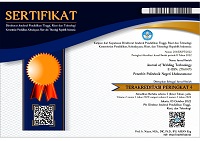Analysis of Defects in SMAW Welding Joint Using E 7016 Electrode Due to the Direct Cooling Process
Abstract
Welding defects in a construction if repairs are not immediately carried out, then in the weld defect area can cause cracks that are aggravated by wider cracking and corrosion so that it can cause brittle fractures to the detriment. The problem with brittle fracture is a big problem in steel that has been welded, especially in welded joints, this brittle fracture becomes more important due to the factors of voltage concentration, inappropriate structure and defects in the weld, the purpose of this study: to find out how to use suitable electrodes for ST 37 material in the welding process, whose cooling process directly uses Oil and water (Direct Colling Process), and to obtain optimal welding results after going through the results of welding defect examination using the Penetrant Test method, and the Maghnetic Particle Test. From the results of the examination research conducted by the Welding Inspection team of PT. Superintending Company of Indonesia (SUCOFINDO) to 15 ST 37 specimens that have undergone welding does not show any welding defects, in the sense that they are still within the acceptable limit criteria (Acceptance Standard Ansi B 31.3), from the results of tensile testing On the use of different electrodes in the welding process of ST 37 material, shows that the ST 37 material whose welding process uses electrode E7016 welded results and tensile strength is better than the ST 37 material which in the welding process uses electrodeS E 7018 with the cooling process using Oil and water
Keywords
Full Text:
PDFReferences
S. A. Sazonova, S. D. Nikolenko, A. A. Osipov, T. V Zyazina, and A. A. Venevitin, “Weld defects and automation of methods for their detection,” in Journal of Physics: Conference Series, 2021, vol. 1889, no. 2, p. 22078.
A. Cosham, P. Hopkins, and K. A. Macdonald, “Best practice for the assessment of defects in pipelines–Corrosion,” Eng. Fail. Anal., vol. 14, no. 7, pp. 1245–1265, 2007.
A. Azwinur, S. Syukran, A. Akhyar, N. H. Tho, and J. Jaswir, “Effect of welding repair on mechanical properties of ASTM A36 carbon steel weld joints,” J. Polimesin, vol. 20, no. 2, pp. 217–221, 2022.
J. F. Lancaster, Metallurgy of welding. Elsevier, 1999.
T. Akbar and B. Santosa, “Analisa Pengaruh dari Welding Sequence Terhadap Tegangan Sisa dan Deformasi pada Circular Patch Weld Dobule Bevel Butt-Joint Plat ASTM A36 Menggunakan Metode Elemen Hingga,” J. Tek. ITS, vol. 1, no. 1, pp. G351–G356, 2012.
S. K. Dwivedi, M. Vishwakarma, and A. Soni, “Advances and researches on non destructive testing: A review,” Mater. Today Proc., vol. 5, no. 2, pp. 3690–3698, 2018.
P. Mrvar, J. Medved, and S. Kastelic, “Welding sequence definition using numerical calculation,” Weld. J., vol. 90, no. 8, 2011.
I. Rizkya, K. Syahputri, R. M. Sari, and I. Siregar, “5S implementation in welding workshop–a lean tool in waste minimization,” in IOP Conference Series: Materials Science and Engineering, 2019, vol. 505, no. 1, p. 12018.
I. Syukran, A. Azwinur, and M. Muhklis, “Analisis Kekerasan Weld Metal Electrode Low Hydrogen Potassium E7016 dan E7018,” J. Weld. Technol., vol. 4, no. 2, 2022.
M. Siddiq, N. Nurdin, and I. Amalia, “Pengaruh jenis kampuh terhadap ketangguhan sambungan pengelasan material St37 dengan AISI 1050 menggunakan proses SMAW,” J. Weld. Technol., vol. 1, no. 1, pp. 11–16, Jun. 2019.
R. Jha and A. K. Jha, “Investigating the effect of welding current on the tensile properties of SMAW welded mild steel joints,” Int. J. Eng. Res., vol. 3, no. 4, 2014.
DOI: http://dx.doi.org/10.30811/jowt.v4i2.3304
Refbacks
- There are currently no refbacks.

This work is licensed under a Creative Commons Attribution-ShareAlike 4.0 International License.
Ciptaan disebarluaskan di bawah Lisensi Creative Commons Atribusi-BerbagiSerupa 4.0 Internasional.
Mailing Address:
Politeknik Negeri Lhokseumawe
Jl. Banda Aceh-Medan
Km. 280,3, Buketrata, Mesjid Punteut, Blang Mangat,
Kota Lhokseumawe, 24301
Propinsi Aceh,
Indonesia























